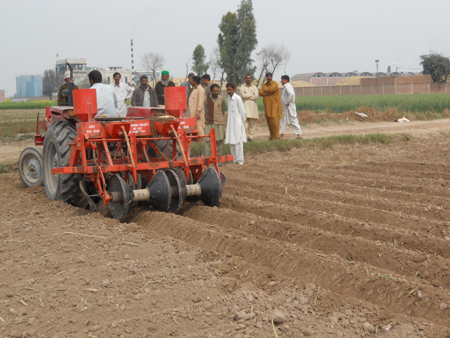Liquid Phosphoric
Acid Application
After nitrogen (N), phosphorus (P) is the second plant nutrient most widely deficient both in normal (82 – 90 %) and salt-affected soils (93 %) of Punjab. Therefore, the plant demand is replenished through fertilization but efficiency (recovery by the plant) of none of the existing fertilizers applied through broadcast, exceeds 20 % owing to the unavoidable chemical reactions in alkaline calcareous soil condition that convert a lion share (80 %) of applied P into forms unavailable to plant. The lower efficiency of existing P fertilizers demands their increased use which is becoming practically difficult due to the present price hike in P fertilizers and withdrawal of subsidies. The higher prices of phosphate fertilizers will reflect into very low applications of P to crops and result in a drastic reduction in yields of field crops in near future.
This will aggravate the already tense situation to meet the demand of the masses for food stuff particularly cereals. This scenario can not be changed with the existing expensive/ inefficient P sources (common fertilizers) and methods of application. The commonly used broadcast method before sowing is wasteful as it greatly limits the usefulness of P fertilizer due to its exposure to more soil surface area where maximum P fixation takes place before it is taken up by the crop. However, banding of P fertilizer through a seed-cum-fertilizer drill can save 70 % of the fertilizer that will result in huge reduction in expenditure incurred on their import.
Morocco and Tunisia are the big exporters of phosphate fertilizers and also export phosphoric acid of agricultural grade (green) in addition to phosphate fertilizers. Ammonification of the raw material (phosphoric acid) to manufacture DAP increases the cost of production. However, direct application of phosphoric acid would certainly be more economical as it omits further processing.
Moreover, it would be helpful in improving structure of our soils which are alkaline calcareous in nature. Previous studies have revealed that application of phosphoric acid dissolved CaCO3 and MgCO3 in soil freeing Ca++ and Mg++. These cations likely reacted with PO4 from the acid to form slightly soluble Ca and Mg phosphates that acted as cementing agent in soil aggregates. In these studies, it was also observed that phosphoric acid application improved the seedling emergence of sugar beet. At NIAB, the effect of phosphoric acid on aggregate stability was also evaluated by using a new technique developed by NIAB scientist for the determination of soil structural stability. The results showed that phosphoric acid addition did not affect the aggregate stability of the soil. At NIAB, effect of high levels of phosphoric acid on organic matter was assessed in soil. No adverse effect of phosphoric acid application was observed on organic matter content of the soil. In a germination test carried out in greenhouse at NIAB, it was observed that band placement of agricultural grade phosphoric acid quite close to the seeds didn’t affect germination of wheat seed.
Objective
Identification of cheaper and efficient alternatives of commercial phosphate fertilizers to help farmers to maintain balanced fertilizer applications for sustaining higher crop productivity
Project Plan
-
Development and evaluation of Band Placement seed drill-cum-liquid fertilizer applicator for wheat
Development and evaluation of Band Placement seed Planter -cum-liquid fertilizer applicator for maize
Project Status
- Design and development of band placement seed drill-cum-liquid fertilizer applicator for wheat has been completed and testing is under process.
- Development & evaluation of band placement seed planter-cum-liquid fertilizer applicator for maize has been completed and testing is under process.
- Gestation period; February 01, 2010 to January 31, 2015
- Total cost: 16.850 million
